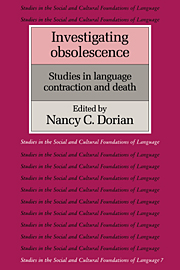Book contents
- Frontmatter
- Contents
- List of maps
- List of contributors
- Preface
- Map
- Dedication
- Introduction
- I Focus on context
- 1 On language death in eastern Africa
- 2 The disappearance of the Ugong in Thailand
- 3 Scottish and Irish Gaelic: The giant's bed-fellows
- 4 The rise and fall of an immigrant language: Norwegian in America
- 5 Breton vs. French: Language and the opposition of political, economic, social, and cultural values
- 6 “Persistence” or “tip” in Egyptian Nubian
- 7 Sociolinguistic creativity: Cape Breton Gaelic's linguistic “tip”
- 8 Skewed performance and full performance in language obsolescence: The case of an Albanian variety
- 9 On the social meaning of linguistic variability in language death situations: Variation in Newfoundland French
- 10 The social functions of relativization in obsolescent and non-obsolescent languages
- II Focus on structure
- III Invited commentaries
- Bibliography
- Index of languages
- General index
6 - “Persistence” or “tip” in Egyptian Nubian
Published online by Cambridge University Press: 08 January 2010
- Frontmatter
- Contents
- List of maps
- List of contributors
- Preface
- Map
- Dedication
- Introduction
- I Focus on context
- 1 On language death in eastern Africa
- 2 The disappearance of the Ugong in Thailand
- 3 Scottish and Irish Gaelic: The giant's bed-fellows
- 4 The rise and fall of an immigrant language: Norwegian in America
- 5 Breton vs. French: Language and the opposition of political, economic, social, and cultural values
- 6 “Persistence” or “tip” in Egyptian Nubian
- 7 Sociolinguistic creativity: Cape Breton Gaelic's linguistic “tip”
- 8 Skewed performance and full performance in language obsolescence: The case of an Albanian variety
- 9 On the social meaning of linguistic variability in language death situations: Variation in Newfoundland French
- 10 The social functions of relativization in obsolescent and non-obsolescent languages
- II Focus on structure
- III Invited commentaries
- Bibliography
- Index of languages
- General index
Summary
“In terms of possible routes toward language death it would seem that a language which has been demographically highly stable for several centuries may experience a sudden ‘tip’ after which the demographic tide flows strongly in favor of some other language.”
(Dorian 1981:51)The picture of Nubia and Nubian history was originally drawn by historians and archaeologists; in recent times, anthropologists and modern linguists have contributed their works. Actually, the first linguists were travellers in the seventh century who discovered and recorded the Nubian dialects of the Nile Valley. But it was not until the nineteenth century that specific studies dealt with these dialects, studies such as that of Reinisch in 1879, or Lepsius in 1840–53.
In the twentieth century starting as early as 1910, there was a discovery of ancient text written in Nubian. Scholars became interested in finding out the affinity between the Nubian language and other languages, and between the different dialects of Nubian.
Nubian has historically been classified as:
Mixed negro by Lepsius (1880);
Proto-Hamitic by Reinisch (1911) (“Proto” postulates Hamitic in its earliest underdeveloped stage);
Sudanic by Westermann (1911) and Meinhof (1912);
Eastern Sudanic by Greenberg (1948), MacGaffey (1961) and Trigger (1965).
Today there is a preponderance of opinion that Nubian is an Eastern Sudanic language, a branch of Nilo-Saharan. The Eastern Sudanic people settled in the Nile Valley and brought their language, which became the Nubian of the present day.
- Type
- Chapter
- Information
- Investigating ObsolescenceStudies in Language Contraction and Death, pp. 91 - 102Publisher: Cambridge University PressPrint publication year: 1989
- 4
- Cited by



